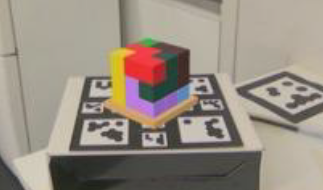
Light Field (LF) microscopy has emerged as a fast-growing field of interest in recent years due to its undoubted capacity of capturing in-vivo samples from multiple perspectives. In this work, we present a framework for Volume Reconstruction from LF images created following the setup of a Fourier Integral Microscope (FIMic). In our approach we do not use real images, instead, we use a dataset generated in Blender which mimics the capturing process of a FIMic. The resulted images have been used to create a Focal Stack (FS) of the LF, from which Epipolar Plane Images (EPIs) have been extracted. The FS and the EPIs have been used to train three different deep neural networks based on the classic U-Net architecture. The Volumetric Reconstruction is the result of the average of the probabilities produced by such networks.

This paper proposes a novel method for automatic realtime defect detection and classification on wood surfaces. Our method uses deep convolutional neural network (CNN) based approach Faster R-CNN (Region-based CNN ) as detector and MobileNetV3 as backbone network for feature extraction. The key difference of our approach from the existing methods is that it detects knots and other type of defects efficiently and does the classification in real-time from the input video frames. Speed and accuracy is the main focus of our work. In the case of the industrial quality control and inspection such as defects detection, the task of detection and classification needs to be done in real-time on a computationally limited processing units or commodity processors. Our trained model is a light weight, and it can even be deployed on systems for example mobile and edge devices. We have pre-trained the MobileNet V3 on large image dataset for feature extraction. We use Faster R-CNN for detection and classification of defects. The system does the real-time detection and classification on an average of 37 frames per second from input video frames, using low cost and low memory GPU (Graphics Processing Unit). Our method has achieved an overall accuracy of 99% in detecting and classifying defects.

The field of image and video quality assessment has enjoyed rapid development over the last two decades. Several datasets and algorithms have been designed to understand the effects of common distortions on the subjective experiences of human observers. The distortions present in these datasets may be synthetic (applying artificially computed blur, compression, noise, etc.) or authentic (in-capture lens flare, motion blur, under/overexposure, etc.). The goal of quality assessment is often to quantify the loss of visual "naturalness" caused by the distortion(s). We have recently created a new resource called LIVE-RoadImpairs, which is a novel image quality dataset consisting of authentically distorted images of roadways. We use the dataset to develop a no-reference quality assessment algorithm that is able to predict the failure rates of object-detection algorithms. This work was among the overall winners of the PSCR Enhancing Computer Vision for Safety Challenge.

The number of spikes, spikelets per spike, number of spikes per square meter are essential metrics for plant breeders and researchers in predicting wheat crop yield. Evaluating the crop yield based on wheat ears counting is still done manually, which is a labor-intensive, tedious and costly task. Thus, there is a significant need to develop a real-time wheat spikes/ears counting system for plant breeders for effective and efficient crop yield predictions. This paper proposed two deep learning-based methods based on EfficientDet and Faster-RCNN to detect and count the spikes. The images are taken using high-throughput phenotyping techniques under natural field conditions, and the algorithms localize and automatically count wheat spikes/ears. Faster R-CNN with Resnet50 as backbone architecture produced an overall accuracy of 88.7% on the test images. We also used recent stateof- the-art models EfficientDet-D5 and EfficientDet-D7, having backbone architectures EfficientNet-B5 and EfficientNet- B7, respectively. A comprehensive quantitative analysis is performed on the standard performance metrics. In the analysis, the EfficientDet-D5 model produces an accuracy of 92.7% on the test images, and EfficientDet-D7 produces an accuracy of 93.6%.

Mixed reality systems are often reported to cause user discomfort. Therefore, it is important to estimate the timing at which discomfort occurs and to consider ways to reduce or avoid it. The purpose of this study is to estimate the discomfort of the user while using the MR system. Psychological and physiological indicators during task were measured using the MR system, and a deep learning model was constructed to estimate psychological indicators from physiological indicators. As a result of 4-fold cross-validation, the average F1 value of each discomfort score was 0.602 for 1, 0.555 for 2, and 0.290 for 3. This result suggests that mild discomfort can be detected with a certain degree of accuracy.